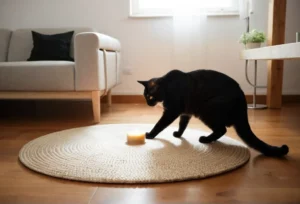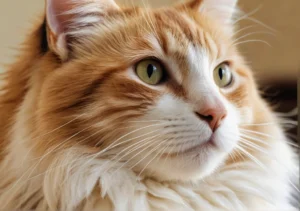Sometimes, cats can seem like they’re auditioning for a marathon with their relentless pacing in circles. If you’ve noticed your cat doing this, it’s not just a quirky behavior; there’s likely more at play than meets the eye.
Pacing in circles can indicate a range of underlying issues, from anxiety and stress to neurological conditions. It’s crucial to observe their behavior closely to pinpoint the cause. But hold up! There’s much more to uncover about this intriguing feline habit that you won’t want to miss.

What are the common reasons for circular pacing?
Cats can exhibit circular pacing for several reasons, both instinctual and health-related. One of the more common explanations ties back to their hunting instincts. Cats are natural predators, and the circular pacing could be a form of stalking behavior, mimicking the movements they’d make while chasing down prey. This kind of pacing might happen if they’re feeling particularly playful or bored.
However, it’s crucial to keep an eye on other signs that could indicate something more serious. For instance, cognitive dysfunction syndrome (CDS) is a condition similar to dementia in humans. If your cat is older and pacing aimlessly, CDS might be at play. Look for additional symptoms like disorientation or disrupted sleep patterns.
Health-related issues can also be significant contributors. Pain or discomfort from conditions like arthritis, hyperthyroidism, or even neurological disorders can lead to this behavior. If your cat is pacing and shows signs of distress or pain, it’s time to consult with your vet.
Before assuming the pacing is purely behavioral, consider these common triggers:
- Hunger: Your cat might be looking for food or treats.
- Attention-Seeking: Sometimes, they just want your company!
- Stressors: Changes in their environment, like moving or new pets, can lead to anxious pacing.
Identifying the motivation behind your cat’s circular movements involves observing their overall health and the context in which this behavior occurs.
Is my cat anxious or stressed?
Pacing in circles often indicates that your cat is dealing with anxiety or stress. Recognizing these signs can help you figure out if your furry friend needs a little extra support.
Anxiety in cats can manifest in many ways. If you notice excessive grooming, litter box issues, or sudden aggression, these might signal that your cat’s feeling uneasy. Pacing is a physical outlet for that anxiety, serving as a coping mechanism for stress.
Take a moment to evaluate their environment too. Are there loud noises or new pets that might be causing them distress? Simple modifications, like creating a quiet space with a cozy hiding spot or using calming pheromone diffusers, can make a big difference.
Here are some symptoms to watch out for:
- Vocalization: Increased meowing or yowling can indicate stress.
- Changes in Appetite: Eating less or more than usual could be a sign.
- Hiding: Cats often retreat when they’re overwhelmed.
If you spot these signs paired with circular pacing, it’s wise to consult with a veterinarian or an animal behaviorist. They can provide tailored strategies to help ease your cat’s anxiety and improve their quality of life.
For more comprehensive insights into feline anxiety, consider checking out the ASPCA guide on Cat Behavior.
Could there be a medical issue involved?
Pacing in circles can signal underlying medical issues that deserve attention. If your cat seems restless and keeps going in circles, it might be more than just quirky behavior.
Neurological disorders are one possible culprit. Conditions like feline cognitive dysfunction syndrome (similar to Alzheimer’s in humans) can cause disorientation and pacing. Keep an eye out for other signs, such as changes in litter box habits or altered social interactions.
Pain is another common reason. If your cat has an undisclosed injury or arthritis, they might pace to try to find comfort or alleviate discomfort. Look for any signs of limp or reluctance to jump up.
Additionally, hyperthyroidism can lead to increased activity levels. Signs include excessive thirst and weight loss despite a good appetite. There’s also the possibility of anxiety or stress, especially if there have been environmental changes recently, such as a move or the arrival of new pets.
Don’t hesitate to consult your vet if this pacing persists or is accompanied by other symptoms. It’s always best to rule out health issues first.
How does age impact my cat’s behavior?
As cats age, their behaviors can shift in surprising ways. Kittens might exhibit more playful, spontaneous pacing, often due to bursts of energy and curiosity, while adults may pace out of sheer restlessness or as a part of their established routine.
In contrast, senior cats might circle due to cognitive decline or discomfort. Older cats can suffer from conditions like arthritis or organ dysfunction, leading them to seek familiar paths as they search for comfort or a good resting spot.
Changes to watch for include:
- Increased disorientation: Especially in cats over 10 years old, which can signal cognitive decline.
- Chronic pain or stiffness: Leading to irregular pacing as they look for a comfy position.
- Altered social interactions: Older cats may become withdrawn, leading to pacing as they search for familiar areas or companionship.
Spend some time observing your cat’s overall behavior. Routine changes or pacing that intensifies can mean it’s time for that vet visit to explore any age-related health concerns or adjustments you can make at home to keep them comfortable. For more insights on feline health, check out the Cornell University College of Veterinary Medicine here.
Are there environmental factors at play?
A cat pacing in circles could be a sign that something’s off in their environment. Cats are highly sensitive to changes in their surroundings, whether it’s new furniture, loud noises, or unfamiliar scents. Reflect on any shifts in your home—like a recent move, the arrival of a new pet, or construction happening nearby.
To create a more calming atmosphere, consider these adjustments:
- Hide distractions: Close curtains or blinds to block out sights that might cause agitation.
- Use calming scents: Cat-safe essential oils or diffusers can help promote relaxation. Just make sure any oils you use are safe for pets.
- Provide quiet spaces: Create cozy, private spots for your cat to retreat to when they need a break from the action.
Also, examine their daily routine. A consistent schedule for feeding, play, and quiet time can help restore a sense of normalcy and reduce anxiety-driven pacing. Engaging in regular interaction can really make a difference too; it reassures your cat that they’re in a loving, stable environment.
How can I help my cat feel more secure?
Creating a sense of security for your cat can significantly reduce their pacing habits. One effective approach is to enrich their environment. Leaving your cat with interactive toys, puzzle feeders, or even a cat tree can engage their natural hunting instincts and keep their mind occupied. Creating a stimulating environment often diverts their attention from the urge to pace.
Additionally, consider these practical tips:
- Designate safe zones: Use cat trees, cozy beds, or blankets in quiet areas where your cat can feel safe.
- Employ playtime: Schedule regular play sessions with your cat. This not only encourages physical activity but also provides them a chance to bond with you.
- Incorporate vertical spaces: Cats love to climb! Install shelves or provide cat condos for them to explore above the ground.
For extra support, look into calming products like Feliway, a synthetic pheromone spray that can create a soothing environment. If pacing continues despite your efforts, consulting with a veterinarian may be a wise choice. They can rule out any underlying medical issues that could contribute to anxiety-related behaviors.
For more tips on creating a cat-friendly environment, check out this resource from the American Society for the Prevention of Cruelty to Animals (ASPCA) on enriching your cat’s life.
What other unusual behaviors should I watch for?
Pacing in circles might be just one piece of the puzzle when it comes to your cat’s well-being. Keep an eye out for additional behaviors that could help you identify what’s really going on.
- Vocalization Changes: If your cat is suddenly meowing more than usual or making unusual sounds, this could indicate distress or discomfort.
- Aggression or Irritability: An increase in aggressive behavior towards people or other pets can signal anxiety or underlying pain.
- Overgrooming or Excessive Litter Box Use: Watch for signs of stress like overgrooming or a sudden change in litter box habits, which could suggest that your cat is feeling unwell emotionally or physically.
- Hiding or Withdrawal: If your cat is retreating more than normal, it may be trying to cope with stress or fear.
- Loss of Appetite: A sudden disinterest in food can be a serious red flag and often requires a vet’s attention.
These behaviors can often indicate health issues, so it’s wise to keep tabs on your kitty. If the pacing persists and it’s coupled with other troubling symptoms, consider reaching out to your vet for a check-up.
What interesting facts about cat behavior exist?
Cats are truly fascinating creatures, and understanding their behavior can shed light on what that pacing might mean. For example, did you know that pacing can sometimes be a self-soothing mechanism? When cats feel anxious or excited, they often resort to this repetitive behavior as a way to calm themselves down.
Another incredible aspect of cat behavior is their strong territorial instincts. A cat might pace if they feel that their territory is threatened, possibly due to new pets in the area or changes in the household. This behavior could be their way of reclaiming their space and asserting their comfort.
Moreover, cats use body language extensively to communicate. So, while a cat is pacing, pay attention to their tail position, ear movements, and overall body posture. Tail pointed upward? They might be alert and curious. If their body is tense and ears are back, this could mean they’re feeling stressed.
To dive deeper into feline behavior alongside pacing, consider checking out resources such as the American Association of Feline Practitioners, which offers insights into a variety of cat behaviors and health tips.
Alex, a passionate animal lover, has experience in training and understanding animal behavior. As a proud pet parent to two dogs and three cats, he founded AnimalReport.net to share insights from animal experts and expand his knowledge of the animal kingdom.




